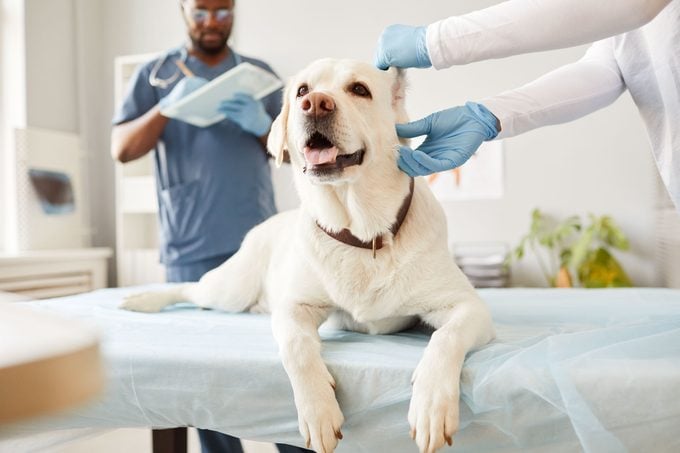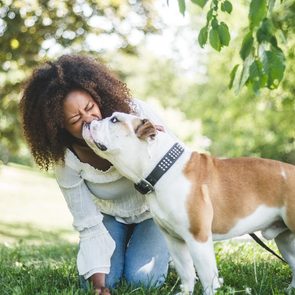Male vs. Female Dogs: What Are the Real Differences?
Updated: Apr. 23, 2024

Male and female dogs are not the same, but do those differences really matter? We asked a vet to find out.
There are so many things to think about when you’re looking for a new canine companion. Dog behavior, size, age, grooming needs and activity level are all important, but what about male vs. female dogs? Is a dog’s sex something else you should take into consideration before making your decision?
Having been a veterinarian for more than 25 years and a dog parent for even longer, I’ve gotten to know thousands of dogs. Some have conformed to gender stereotypes, while others have not. For example, conventional wisdom says that male dogs are more affectionate than females, and yet, the most affectionate dog I’ve ever had the pleasure of knowing was a male mixed breed named Owen. He followed me everywhere and was simply the most adoring dog you could ever hope to meet. On the other hand, male dogs are also supposed to roam more than females, but it was my female terrier mix, Annie, who simply wouldn’t be fenced in. This little escape artist came to me as a stray, broke out of my well-fenced yard on multiple occasions and loved nothing more than to explore as many mountainsides as possible when we were on hikes together.
But are there some general truisms about male and female dogs? Ahead, we’ll explore what research and anecdotal evidence have to say about the importance of a dog’s sex.
Get Reader’s Digest’s Read Up newsletter for more pets, humor, cleaning, travel, tech and fun facts all week long.
| Reviewed for accuracy by: Wailani Sung, DVM, a vet with a board certification in veterinary behavioral medicine who owns Bay Area Vet Behavior. Dr. Sung is the co-author of From Fearful to Fear Free: A Positive Program to Free Your Dog from Anxiety, Fears and Phobias. |
Does a dog’s sex matter?
Yes and no. Scientific research looking at groups of dogs has found some meaningful differences between males and females, but results like these become almost meaningless if you are interested in the characteristics of a specific dog. For example, spaying female dogs may sometimes lead to increased aggression. However, that spayed female pup you meet at the shelter might be the sweetest thing ever and want nothing more than to sleep in your bed every night. The bottom line: The characteristics of an individual dog are far more important than generalities about their sex. Spending time with a dog, ideally in a variety of situations, is the best way to get a feel for whether its personality will be a good match for you.
Personality differences between male and female dogs
With that said, sex hormones can play some role in shaping a dog’s personality and behavior. Spaying and neutering have a big effect on a dog’s hormonal levels as well, though: Dogs that have been spayed or neutered, particularly at a young age, will usually have fewer hormone-related behaviors.
Personality of male dogs

Male dogs that have not been neutered have high levels of testosterone, and testosterone is associated with the problematic behaviors most commonly seen in male dogs. Of course, testosterone isn’t all bad, and it may also play a role in some of the more endearing traits of male dogs.
- Male dogs like to roam. The wild ancestors of dogs were frequently on the move. Males, in particular, had to roam large distances to find mates and defend their territories. This desire to get out and explore is often most evident in intact (non-neutered) male dogs and can lead to problems like getting into dog fights, becoming lost and getting injured.
- Intact male dogs may be more aggressive. In their quest to find a mate, male dogs often have to fight other male dogs. These aggressive tendencies can spill into other parts of their lives, including in their interactions with people. Several studies, including one published in the journal Nature in 2021, have shown that aggression tends to be more common in male vs. female dogs.
- Humping is a bigger problem in male dogs. Humping isn’t always a sexual act in dogs. It’s often just a way to communicate or get attention, or a sign of emotional arousal. That said, male dogs do tend to hump more than females. Dogs can hump other dogs, people and even inanimate objects, which may lead to some awkward conversations!
- Territorial behaviors are more common in males. Male dogs tend to urinate on objects in their environment to mark their territories, which is basically a way of saying, “This area is mine—stay away.” All those stops to pee can make walks slow and more than a little frustrating, but this behavior does have an evolutionary basis. Sometimes the marking behavior can move indoors, which is why you might be looking up how to get dog pee out of your carpet and other surfaces more often than you’d like.
- Male dogs may be more affectionate. People often say that male dogs are more affectionate than females, but there hasn’t been any research to show whether this is actually the case. Of course, it’s the individual’s personality that matters most, but for what it’s worth, my male dogs have always been more willing to dole out the kisses than my females. Many pet parents also say that their male dogs are more active and playful than their female dogs.
Personality of female dogs

The hormones estrogen, progesterone and oxytocin are all critical to a female dog’s heat cycle and ability to become pregnant and raise a litter of puppies. They may also play a role in some of the personality traits and behaviors that are thought to be more typically female.
- Female dogs tend to be calmer than males. While there haven’t been any scientific studies on the subject, female dogs are often said to be calmer than males. Maybe raising pups requires a degree of level-headedness that male dogs, who aren’t so involved in the upbringing of their offspring, don’t need.
- Female dogs may be easier to train. One study published in Royal Society Open Science in 2017 found that female dogs scored higher than male dogs on measures of obedience, which should make them easier to train. And if female dogs truly are calmer than males, they may be better able to focus on what’s being taught rather than being distracted by every squirrel that runs by.
- Unspayed female dogs need to nurture. After an unspayed female dog goes through her heat cycle, she experiences all the hormones associated with pregnancy, even if she’s not carrying pups! This means that about two months after her heat cycle is over, you might see your dog getting ready to take care of puppies. She may even build a nest. These nurturing tendencies can surface at other times as well, such as when she gently carries a stuffed animal around in her mouth or comforts you when you’re upset.
- Loyalty is a trait often associated with female dogs. In my experience, male and female dogs are both capable of intense loyalty. Nevertheless, females tend to have higher levels of oxytocin, the hormone that promotes bonding between mothers and their offspring, which may explain why female dogs are sometimes said to be more loyal than males. But according to a study published in Science in 2015, you and your female or male dog can experience higher oxytocin levels simply by staring into each other’s eyes.
Health differences in male and female dogs
Dogs of one sex aren’t necessarily healthier than the other, but certain health problems are more common in male vs. female dogs. Of course, conditions that affect the reproductive tract will vary, but there are some surprising differences as well. I can’t explain why, but every dog that I’ve treated for gastric dilatation and volvulus (a potentially fatal twisting of the stomach) has been a male.
Health of male dogs

Male dogs are prone to certain health problems because of their anatomy and hormones. Knowing which diseases are most common in your dog will help you know what symptoms to watch for.
- Testicular tumors can develop when male dogs aren’t neutered. Tumors involving the testicles are the most common form of reproductive-tract cancer in male dogs. Most tumors develop later in life and are malignant, although neutering can cure the condition if it’s caught early enough. Neutering is also the best way to prevent testicular tumors in dogs.
- Prostate-gland diseases are common. The prostate gland may cause problems, particularly as dogs age. Benign prostatic hyperplasia (BPH) is the most common prostate disease and usually affects older, intact male dogs, but infections, cysts and cancer are also possible. How will you know if your dog has a prostate issue? These diseases cause the gland to enlarge, which may make it hard for the dog to pee and poop.
- Tumors around the anus can cause trouble. High testosterone levels increase the risk that a dog will develop a type of tumor called a perianal gland adenoma. Most of these tumors are benign, but they may need to be removed to prevent infections; if they get large enough, they can also block the normal passage of poop, causing dogs to strain or poop small amounts more frequently than is normal.
- Male dogs have more inherited joint problems. Perhaps it’s because they tend to grow faster and larger in comparison to females, but male dogs are more likely to develop symptoms associated with joint problems that they inherit from their parents. For example, elbow dysplasia is more common in male vs. female dogs, and while hip dysplasia affects both sexes equally, the condition tends to progress more quickly in males. Affected dogs often develop arthritis in their affected joints, sometimes at a very young age.
Many of these health problems can be prevented by neutering male dogs, but a few actually become more likely, particularly in certain breeds, if dogs are neutered before they have fully matured. For example, it’s best not to neuter male golden retrievers until after they are 1 year old because dogs who are neutered before this time have an increased risk of cancer and joint problems. A veterinarian can help you determine the best time to neuter your dog.
Health of female dogs

Health problems affecting the ovaries and uterus obviously only affect female dogs, but other conditions are more likely as well if your dog is a female—particularly if she isn’t spayed or was spayed later in life.
- Mammary tumors are common in unspayed female dogs. Because of the effects of estrogen, both benign and malignant mammary (breast) cancer is much more common in female vs. male dogs. Get your dog seen by a veterinarian whenever you notice a lump or bump, because early treatment yields the greatest chance of success. Spaying a dog before she has gone through her first heat cycle almost eliminates the risk of mammary tumors, but this protection disappears after she has gone through two heats.
- Uterine infections can be deadly. A female dog’s uterus can become infected and filled with so much pus that it ruptures. This condition is called pyometra, and it develops because of the hormone changes that dogs go through after every heat cycle. Spaying a dog will block these hormonal shifts and also prevent pyometra. Up to 25% of unspayed female dogs will develop this condition during their lives.
- Female dogs can develop ovarian cancer. Spaying a dog involves removing her ovaries, so her risk of ovarian cancer is eliminated after the surgery. Ovarian cancer can be benign or malignant, but luckily, it isn’t very common, probably because most pet parents elect to spay their dogs before the condition has a chance to develop.
- Urinary tract problems are common. The female urethra is short and wide, giving bacteria easier access to the bladder and increasing the risk of a urinary tract infection. Signs of a urinary tract infection can include experiencing discomfort when urinating, producing small amounts of urine frequently and having accidents in the house. And while spaying helps prevent many health problems in female dogs, some will leak urine after being spayed. Thankfully, medications will usually improve the situation.
A veterinarian can help you figure out if and when your female dog should be spayed based on their breed and overall health status.
FAQs about male vs. female dogs

Are male dogs more affectionate?
Male dogs have a reputation for being more affectionate than females, but in truth, you can find many extremely affectionate female dogs and some male dogs who prefer to be left alone. What’s most important is the individual dog’s temperament. Some breeds also tend to be more affectionate than others.
Do female dogs prefer female owners?
Not necessarily. Both female and male dogs feel more comfortable with the types of people they’ve had positive experiences with in the past. So if a female dog had been cared for by a loving female owner, they probably would prefer females, but the same thing would apply to a male dog who had previous good experiences with women.
Are male or female dogs better for emotional support?
Both females and males can be wonderful emotional support dogs; it really depends on the traits you’re looking for. Conventional wisdom says that female dogs may be calmer and more loyal, while males may be more outwardly affectionate, but these are only generalizations and do not apply in every case.
Are female dogs less aggressive?
Studies have shown that, in general, female dogs are less aggressive than males. However, any dog can act aggressively when they are frightened or put in situations that they find threatening.
Are female dogs more loyal?
You’ll often hear people say that female dogs are more loyal than males, but in my experience, both males and females can be incredibly loyal. An individual dog’s personality and how they have been treated by the people around them are far more important than their sex in determining how loyal they will be.
Are male dogs harder to potty train?
There isn’t much of a difference when it comes to potty training male or female dogs. Both sexes require close monitoring, frequent trips outside and lots of positive reinforcement while they are being potty trained. Putting your dog in a comfortable crate when you can’t keep an eye on them can help immensely. However, marking can be a hard habit to break, and it is more common in males than females. Get advice from your veterinarian as soon as possible if your dog likes to pee on everything they see.
Do dogs prefer male or female owners?
Some dogs seem to prefer women over men, probably because traits that are more typically female (a higher voice, for example) are less threatening and more appealing to dogs. However, other dogs prefer men, particularly if they’ve had good experiences with them in the past or if they’ve had bad experiences with women.
Why trust us
At Reader’s Digest, we’re committed to producing high-quality content by writers with expertise and experience in their field in consultation with relevant, qualified experts. For this piece, Jennifer Coates, DVM, tapped her experience as a veterinarian with more than 25 years of professional experience, and then Wailani Sung, DVM, DACVB, PhD, a veterinarian specializing in behavioral medicine and the co-author of From Fearful to Fear Free: A Positive Program to Free Your Dog from Anxiety, Fears and Phobias, gave it a rigorous review to ensure that all information is accurate and offers the best possible advice to readers. We verify all facts and data, back them with credible sourcing and revisit them over time to ensure they remain accurate and up to date. Read more about our team, our contributors and our editorial policies.
Sources:
- Nature: Scientific Reports: “Aggressive behaviour is affected by demographic, environmental and behavioural factors in purebred dogs”
- Royal Society of Open Science: “Assessment of owner-directed aggressive behavioural tendencies of dogs in situations of possession and manipulation”
- Science: “Oxytocin-gaze positive loop and the coevolution of human-dog bonds”
- BMC Veterinary Research: “Prevalence of commonly diagnosed disorders in UK dogs under primary veterinary care: results and applications”
- Frontiers in Veterinary Science: “Assisting Decision-Making on Age of Neutering for 35 Breeds of Dogs: Associated Joint Disorders, Cancers, and Urinary Incontinence”




